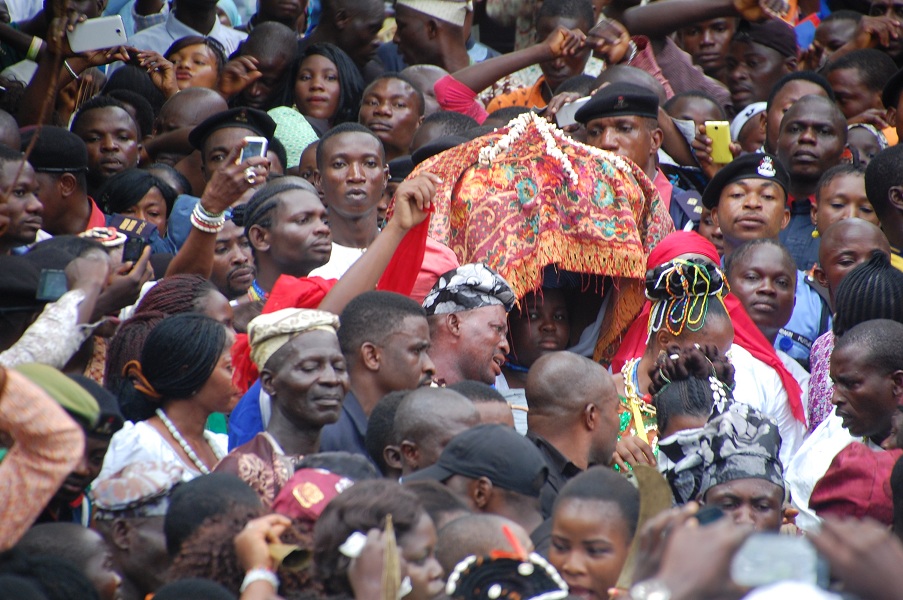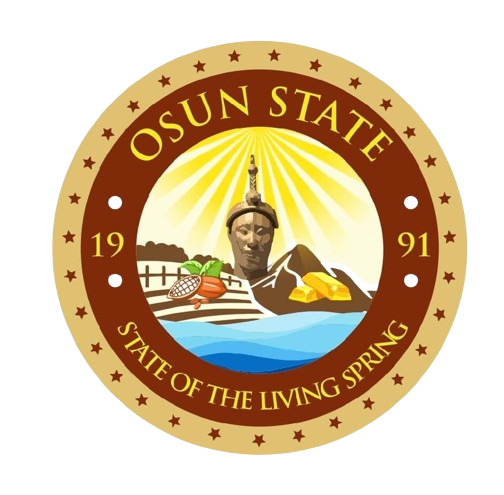
Osun Osogbo: Grandeur Of The Grand Finale
 The Osun Osogbo day goes gay in celebration of her founder’s day in spite of seeming economic challenges. AGOZINO AGOZINO, who followed this year’s event, offers a review.
The Osun Osogbo day goes gay in celebration of her founder’s day in spite of seeming economic challenges. AGOZINO AGOZINO, who followed this year’s event, offers a review.
The event, which is Osogbo’s biggest export, had begun two weeks ago; with the traditional environmental sanitation exercise called Iwopopo (cleansing of road). Thus all major roads in the city were cleared of debris and filth. Everywhere in the town must be made clean and tidy to celebrate the festival because the goddess abhors dirt, with her devotes always in clean white apparel.
Her steps were carefully calculated, firm and sure. Her face reflected the seriousness, and the commitment, of the task at hand. Oba Jimoh Olanipekun and his high chiefs followed her with bold assurance. The crowd was wild with joy. The atmosphere was one of communal participation, great expectations, and high drama as the Arugba Osun, the votary maid of the ancient festival, carried this year’s ritual calabash reverently towards the Osun River.
It was last Friday. And what was unfolding was this year’s edition of Osun Osogbo Festival. The procession from the aafin (palace) at the Oja-Oba to the Osun River marked the highpoint of the celebration of life by Osogbo indigenes.
The reason of the cleaning, according to some devotees of the river deity, is that while physically Osogbo’s roads have been cleared of dirt and obstacles, spiritually too, “our life is also cleared of anything that may hinder our progress in this life.” It also implies that spiritual security has been put in place at the strategic locations around the town.
However, there are other aspects of the two weeks fiesta, which are not meant for public consumption and these are usually restricted to the palace of the Ataoja.
The next public activity is the lighting of the Ataoja Olojumerindinlogun Osanyin, a 642-years-old lamp. The lamp has 16 wicks, and according to the tradition, must be lit at dusk and kept burning till dawn. The Ataoja, along with some of his chiefs, must dance round the lamp three times. While doing this, they all must invoke the spirit of the ancestors to bless them and the townsfolk. The festival was kicked off by the youthful Ataoja, Oba Olanipekun, and his chiefs.
Another significant rite is the Iboriade ritual. The crown and all other royal paraphernalia are put on display for members of every ruling family in Osogbo. Prayers are said for each of the past Ataojas for their contributions to the development of the town during their lifetime. This is rounded off by the reigning Oba who offers prayers for himself and all present.
After this comes the big one, the procession to the Osun riverbank by the whole town, led by the Arugba Osun. The main rituals are performed at the Ojubo, the sacrificial spot inside the Osun grove. According to tradition, the Ojubo is the very spot where the first Ataoja of Osogbo, Larooye, made his original pact with Osun, the goddess of the river, hundreds of years ago when Osogbo was founded. The Ojubo is located within Agbala Osun courtyard. Here, the Ataoja receives his chiefs, delivers his message and offers sacrifices; all the while sitting on the rock on which Larooye reportedly sat during his reign, the very spot where the story of Osogbo town began.
The Ataoja then feeds the fish in the river with items from Igba Osun, which include porridge, corn pudding eko and a vegetable stew, called yanrin. As these are thrown into the river, the crowd raises its voice in prayers, petitions and supplications, worship and thanksgiving to Osun, the Yoruba goddess of fertility, for her numerous blessings over the years. They wave caps, head-ties and hands in the air, while the priest and priestess chant incantations and break into panegyrics in praise of the deity.
At this stage, the Ataoja takes his leave to a cultural reception where different groups, in their numerous uniforms, perform to the delight of all guests, visitors and indigenes. Meanwhile, the crowd, particularly the women, rush into the river bank to drink or wash their faces in it for the water, so the myth goes, is medicinal. It is believed that the water from river, especially at the Ojubo, and particularly after the sacrifice, is potent enough to cure infertility and all kinds of illness.
The festival is also used by some Osogbo youths to settle personal disagreements. Young men are seen wielding long canes, whipping and lashing each other in a test of manhood and endurance. There are also those who use the opportunity to threaten to whip young ladies who may have rebuffed their advances in the past.
Despite the fervor with which many embrace the tradition, there are those who believe the festival is simply a fun and nothing else. One of such people is Fatai Ola, an Osogbo indigene and a “born-again” Christian. “The whole idea that the water can cure illness is false,” he said. “It is just because they have been told to believe such.”
Some of the tourists in this year’s festival came from countries such as Australia, France, the United States, Canada, Cuba, Brazil, Ghana. Last year, the festival was affected by the outbreak of the Ebola Virus Disease (EVD) and was nearly cancelled. This year’s event has, however, returned its groove and it appears the event is gathering more international recognition.
For many years, the Osogbo festival was promoted by the late Austrian conservationist and artist, Susanne Wenger, popularly known as Adunni Ibifunke Olorisha, who came to Nigeria in the late 1950s with late Ullie Beier. The couple helped popularise the Osogbo grove, leading to it being listed as one of the World Heritage Sites by the United Nations Education Scientific and Cultural Organisation (UNESCO) in 2005.
Jimoh Buraimoh, an Osogbo-based artist and key stakeholder of the festival, is particularly happy that this year’s festival is better than last year’s. “I am happy because this year’s event is better than last year,” he said. “The Ebola crisis almost denied us the opportunity last year; but you can see that all that has now changed.”
For Nike Okundaye, another globally respected artist of the Osogbo art school: “We are all happy because if you come here, you will see that everybody in Osogbo is happy. The festival this year is well organised because we were not happy with what happened last year.”
This year’s festival was sponsored by such brands as MTN Nigeria, Goldberg (Nigerian Breweries), Seaman’s Royale (Grand Oaks) and Alomo Bitters (Kasapreko).
According to the Oba Jimoh Olanipekun, the growing number of people from several cultures identifying with the festival shows how much of a world-acclaimed event it has attained. This, according to him, is critical in the preservation of culture and tradition.
“There is the need to fully appreciate and register my gratitude to UNESCO for not only designating the Osun Grove as a World Heritage Monument, but for also elevating the festival beyond the shores of Osogbo, Osun State, Nigeria, to the whole world,” he said. He also used the occasion to urge the Osun people, and Nigerians, not to emulate the attitude of people who throw away their culture. “Your culture is the only way that you can show



